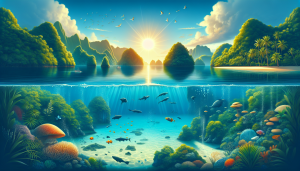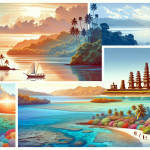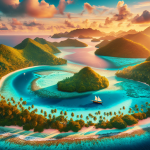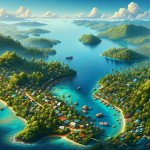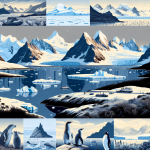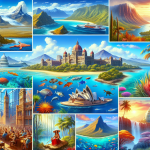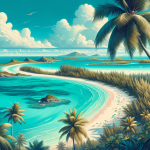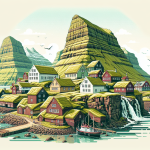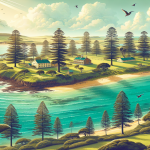Exploring the Wonders of Palau: A Hidden Gem in the Pacific
Nestled in the western Pacific Ocean, Palau is an archipelago that offers a unique blend of natural beauty, rich history, and vibrant culture. This island nation, composed of over 500 islands, is part of the Micronesia region and has become a must-visit destination for travelers seeking both adventure and serenity. Whether you’re an avid diver looking to explore its renowned underwater world, a history buff eager to uncover its World War II relics, or a nature lover enchanted by its lush landscapes, Palau has something to offer everyone. This article will delve into the myriad attractions and experiences that make Palau a hidden gem waiting to be discovered. We’ll explore its pristine beaches, crystal-clear waters, diverse marine life, and cultural heritage, providing a comprehensive guide to making the most of your visit to this enchanting paradise.
The Natural Beauty of Palau
Pristine Beaches and Crystal-Clear Waters
One of the first things that come to mind when thinking about Palau is its stunning beaches and crystal-clear waters. The archipelago boasts some of the most picturesque beaches in the world, with soft white sands and turquoise waters that are perfect for swimming, snorkeling, and sunbathing. Some of the must-visit beaches include Long Beach, Carp Island Beach, and Ngemelis Island Beach. Each of these locations offers a serene environment where you can unwind and soak in the natural beauty.
The Rock Islands
Another highlight of Palau’s natural beauty is the Rock Islands. This UNESCO World Heritage site comprises around 300 limestone and coral islands that are renowned for their unique mushroom-like shape. Exploring the Rock Islands by kayak is an unforgettable experience, allowing you to navigate through hidden lagoons, secluded beaches, and lush greenery. The Rock Islands are also home to the famous Jellyfish Lake, where you can swim with millions of harmless jellyfish—a truly unique and surreal experience.
Diving and Snorkeling in Palau
A Diver’s Paradise
Palau is often referred to as a “diver’s paradise” due to its world-class dive sites. The archipelago’s diverse marine life and underwater landscapes make it a top destination for both novice and experienced divers. Some of the most renowned dive sites include Blue Corner, German Channel, and Ulong Channel. These sites offer the chance to see an array of marine species, including sharks, manta rays, and colorful coral reefs.
Snorkeling Adventures
For those who prefer to stay closer to the surface, Palau also offers excellent snorkeling opportunities. The reef systems around the islands are teeming with vibrant marine life, making it easy to spot tropical fish, sea turtles, and more. Popular snorkeling spots include Milky Way Lagoon, known for its therapeutic white mud, and the Big Drop-off, one of the most spectacular walls in the world for snorkeling.
Cultural Heritage and History
WWII Relics
Palau’s history is rich and varied, with significant events dating back to World War II. The islands were strategic locations during the war, and remnants of this period can still be found today. Exploring the Peleliu Island, you can visit the remnants of military installations, tanks, and aircraft. The Peleliu Battlefield is particularly poignant, serving as a reminder of the intense battles that took place here.
Local Culture and Traditions
Palau’s cultural heritage is equally fascinating. The Palauan people are known for their hospitality and rich traditions. Visiting the Belau National Museum and the Etpison Museum provides insights into the island’s history, art, and culture. You can also experience traditional Palauan dance and music performances, which are an integral part of the island’s cultural landscape.
Adventure Activities in Palau
Kayaking and Paddleboarding
For those seeking adventure, Palau offers a range of activities beyond diving and snorkeling. Kayaking and paddleboarding are popular ways to explore the islands’ waterways and hidden coves. The Rock Islands Southern Lagoon is an ideal location for these activities, offering calm waters and stunning scenery.
Hiking and Nature Trails
Palau’s lush landscapes are perfect for hiking and nature walks. The Ngardmau Waterfall, the highest waterfall in Palau, is a must-visit for nature enthusiasts. The hike to the waterfall takes you through dense jungle and offers a refreshing swim at the end. Another great hike is the Babeldaob Island, which is the largest island in Palau and offers various trails that lead to ancient stone monoliths and stunning viewpoints.
Sustainable Tourism in Palau
Conservation Efforts
Palau is committed to preserving its natural beauty and biodiversity through various conservation efforts. The Palau National Marine Sanctuary is one of the largest fully protected marine sanctuaries in the world, covering an area of 500,000 square kilometers. This sanctuary aims to protect marine life and ensure sustainable fishing practices. Visitors are encouraged to support these efforts by adhering to responsible tourism practices, such as not disturbing marine life and following local guidelines.
Eco-Friendly Accommodations
Many of Palau’s accommodations are committed to sustainable tourism. Eco-friendly resorts and lodges, such as the Palau Pacific Resort and the Carp Island Resort, implement green practices to minimize their environmental impact. Staying at these eco-friendly establishments allows you to enjoy your vacation while contributing to the preservation of Palau’s natural beauty.
Getting to Palau and Practical Information
How to Get There
Palau is accessible via international flights, with the Roman Tmetuchl International Airport serving as the main gateway. Flights connect Palau to major cities in Asia, such as Tokyo, Seoul, and Manila. From the airport, you can easily reach your accommodation via taxis or pre-arranged transfers.
Best Time to Visit
The best time to visit Palau is during the dry season, which runs from November to April. During this period, you can expect pleasant weather and calm seas, making it ideal for outdoor activities and water sports. The wet season, from May to October, brings more rainfall but also fewer tourists, offering a more secluded experience.
Travel Tips
- Respect Local Customs: Palau has a rich cultural heritage, and it’s important to respect local customs and traditions. Dress modestly when visiting villages and cultural sites.
- Stay Hydrated: The tropical climate can be quite warm, so make sure to stay hydrated by drinking plenty of water.
- Protect Yourself from the Sun: Use sunscreen, wear a hat, and bring sunglasses to protect yourself from the sun’s rays.
Conclusion
Palau is a destination that captivates the hearts of travelers with its unparalleled natural beauty, rich history, and vibrant culture. Whether you’re exploring the underwater wonders, soaking in the serene beaches, or immersing yourself in the local traditions, Palau offers an unforgettable experience. By embracing responsible tourism practices and supporting conservation efforts, you can help ensure that this hidden gem remains preserved for future generations to enjoy. So pack your bags and get ready to discover the enchanting paradise that is Palau.
For more information about planning your trip to Palau, visit the official Palau Visitors Authority website.
